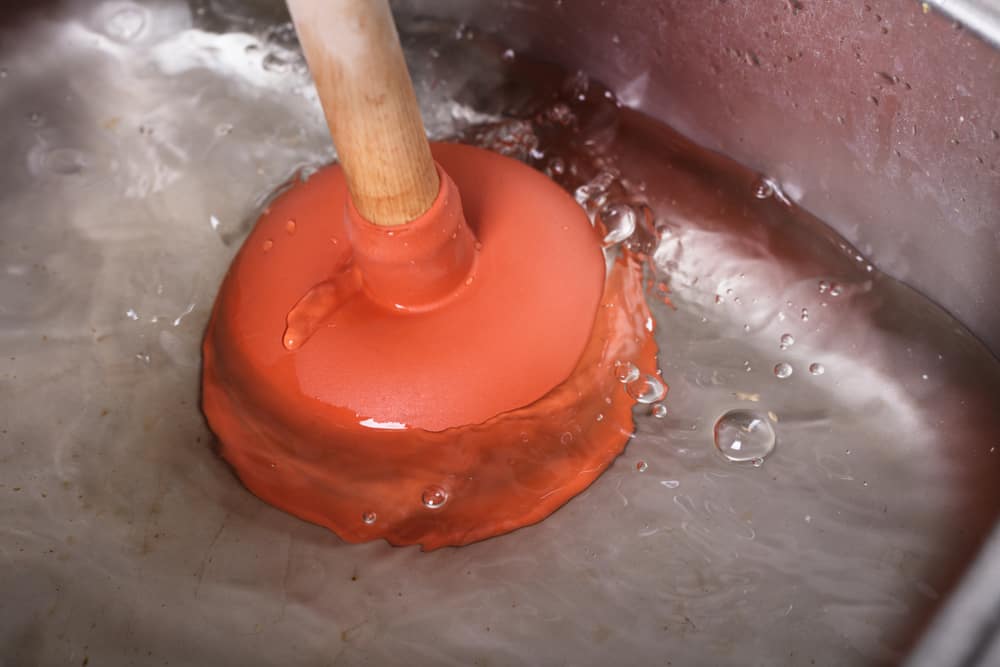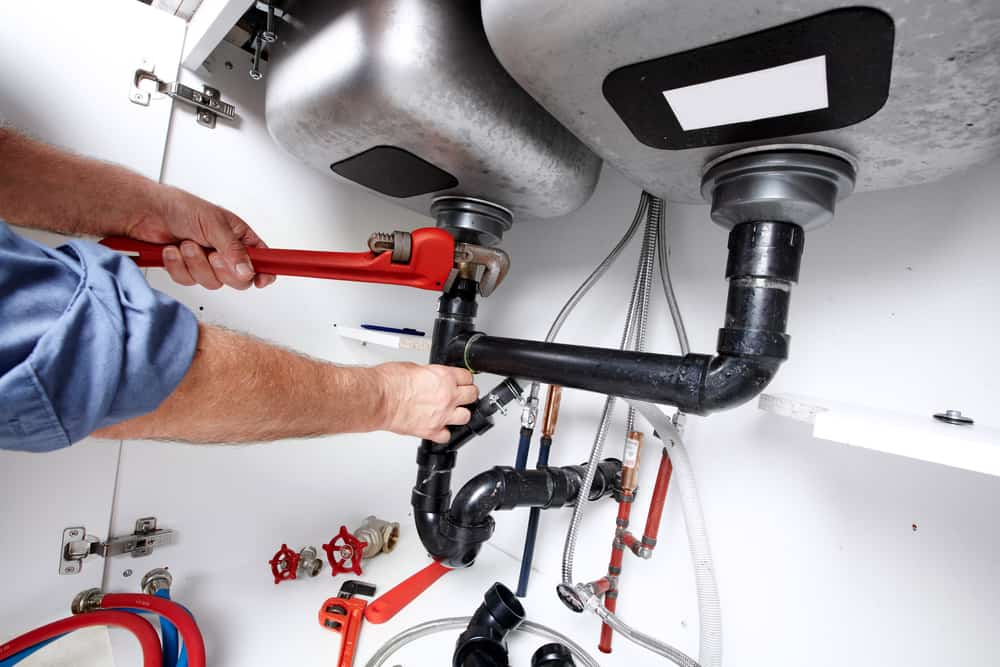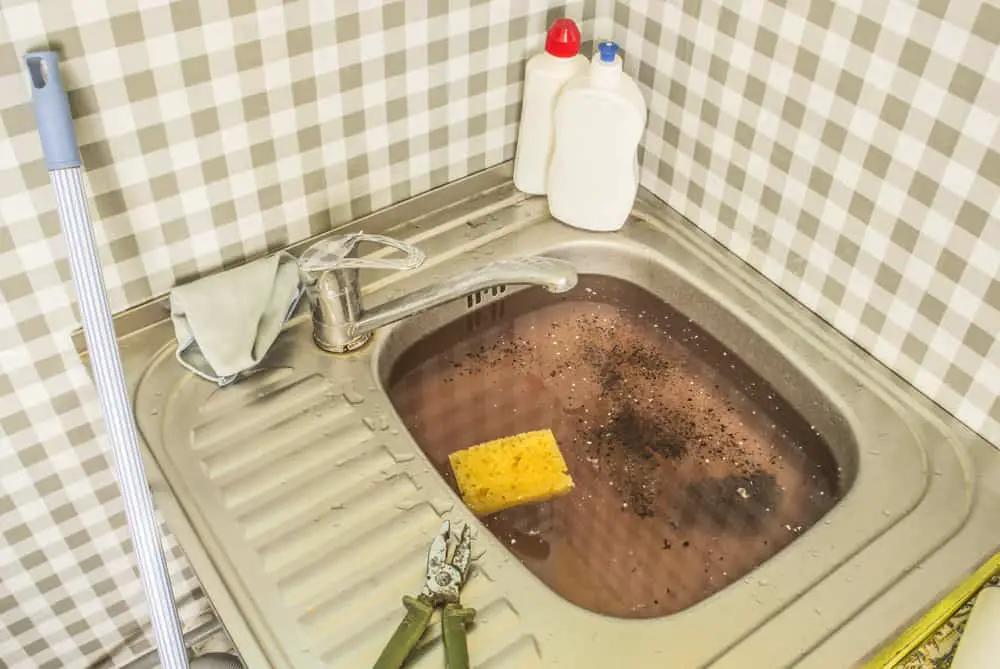Updated on October 11, 2022
Have you ever wondered how to unclog a kitchen sink using your garbage disposal?
The best way to unclog a kitchen sink with your garbage disposal is to use a cup of baking soda and a cup of white wine vinegar to help clear the clog before turning on the disposal, run hot water after. It’s recommended to repeat the process until you clear the clog.
Is it Your Responsibility
Getting the job done as quickly as possible is definitely a priority, but make sure that you aren’t overstepping your place or violating a lease agreement.
While you might think your girlfriend or roommate will appreciate the display of your tenacity and home repair knowledge, they also might not. The thought of the job being incorrectly done and you being covered in dirty water and gunk might be too much for them to process.
Depending on where you live, you’re not allowed to do any unlicensed repairs, so make sure to check that when you first move in. You might not appreciate the surprise when you’re ankle-deep in water in your kitchen with a crumbled-up contract in your hand.
What Causes a Clogged Garbage Disposal

It’s always an annoying inconvenience when you’re running water in the kitchen sink and it doesn’t drain like it’s supposed to.
Coffee Grounds
Coffee grounds are a major culprit for clogging the garbage disposal and kitchen sink. Instead of getting rid of them in the garbage disposal, consider just throwing them out or sprinkle them in your garden.
Debris
All manner of debris, such as hair, paper, and random objects can gunk up the garbage disposal and clog up the pipes.
Many people prefer not to use their garbage disposal for fear of clogging up the drains and creating an unnecessary mess. If that isn’t you no problem. Fortunately for you, there are a number of relatively easy solutions to unclog your sink drain and p-trap with a small amount of time and effort.
Tools You Might Need
Depending on what you might need to do to eliminate any drainage issues for your home repair, you will need some tools.
- Needle nose pliers
- Pipe wrench
- Plunger
- Plumber’s tape
This is just a simple list of tools that you may need for this repair, consider doing further research if your job entails more than just a simple fix.
Ways to Unclog a Kitchen Sink
If your kitchen sink won’t drain and water is in it, you probably have a clog. Try some easy home repair tips to unclog the kitchen drain before you call a licensed plumber.
Use a Plunger
A great way to unclog a kitchen sink is to use a plunger. Place the plunger over the kitchen drain opening and begin to plunge the drain.
This should take care of the clogged sink drain by forcing the blockage and water through the drain line. Repeat the process several times if needed.

Types of Plungers
You might be thinking that all plungers are the same, but there are several different types of plungers available to buy. For the sake of brevity and not getting into the nuances of differences among different plungers and their shape, I’ll mention 3 types of plungers and some of the different shapes and styles they come in — each with a different intended plunge use-case.
Drain Plunger
Its function is clearly stated in the name, drain plungers are meant to be used on drains. Drain plungers are designed to create a lot of suction when used, make sure to remove any drain covers before using.
Toilet Plunger
As the name suggest, they are designed to be used for a commode. Toilet plungers come in several different varieties, such as an accordion plunger, a flange plunger, and the tiered plunger.
Sink Plunger
More along the lines of what you’re looking for when dealing with a clogged kitchen sink, sink plungers, otherwise known as cup plungers, are designed to create seals best on flat surfaces.
They are great to use if you have standing water in your sink and don’t want to crawl under the sink to undo the drain pipe.
Use Baking Soda and White Vinegar
Get elementary or middle school science fair with it — make a not so pleasant volcano. All you need is a little vinegar and baking soda to do the trick.
Steps:
- Clear out your sink if it isn’t already.
- Measure out one cup of baking soda and one cup of white vinegar.
- Pour both of the cups into the drain opening.
- Let sit undisturbed for at least 30 seconds.
- Run water to determine if the clog persists.
- Repeat steps 1-5 if necessary.
Use Drain Cleaner
There are a plethora of drain cleaners sold to unclog a kitchen sink, invest in one to make your life easier.
As simple as 1 2 buckle my shoe, follow the instructions when pouring the drain cleaner down the sink, and await results.
Use a Coat Hanger
If you don’t have a plunger, try using a coat hanger, it can be an effective solution in a pinch. Remove the drain cover and attempt to clear any debris that may be in the kitchen sink by poking the coat hanger inside.
Oftentimes you can fish out the clog or force it down the drain and into the PVC pipes.
Check your work with some water after clearing the drains to ensure the clog has been removed.
Ways to Prevent Clogged Kitchen Sinks
A little routine maintenance can go a long way to prevent any standing water in your kitchen caused by clogs. Do these things on a regular basis to save time and money.
Clean Your Garbage Disposal
Although it’s not a pleasant task, cleaning your garbage disposal out several times a year can help prevent clogs. Remember to use a pair of gloves, no one wants to put a hand in gunk and debris.
Depending on your setup, your garbage disposal might be located on the side of the sink.
Tip:
- Don’t forget to clean the bottom of the unit.
Use Boiling Water
Using water to unclog a drain might not seem practical, but it can be quite beneficial to pour boiling water down your drain pipes occasionally. Doing this several times a year can help clear the drain lines.
You don’t need to fill the sink, but at least use a few gallons. It’s as easy as 1 2 3.
Clean out Your P-Trap
The p-trap, not a shortened version of Parent Trap, is the u-shaped pipe that is designed to hold a little water and prevent gases from the sewer and the likes from traveling up the drain pipe.
Another function of the p-trap is to help prevent clogs, so it’s important that it’s in proper working order.

Water should only be flowing in one direction when it comes to your drain pipe. You don’t want the path of least resistance to be back up the kitchen drain.
Tip:
- A bad smell around the sink can be an indicator that you need to service your p-trap.
Additional Resources
No one likes overflowing water from the sink. If you’re still in need of assistance, there are several options you can choose from to get some help or a tip on getting the job done right.
Check out a Hardware Store
Oftentimes you can find an employee working at a hardware store that used to be a plumber. They can provide tips for getting your repairs done right.
A few pleasantries can go along way to establishing a helpful, mentoring relationship with someone more skilled than your self.
Learn from others firsthand, both their mistakes and triumphs. You’ll be thankful for all of the life lessons and advice in the long run.
Search Online
If nothing’s working for you and you’re out of ideas, consider perusing some online sites for helpful articles with any additional tips and tricks to clearing out the pipes and drain clogs.
There’s a plethora of information out there, so use it to your advantage. No sense in learning everything the hard way.
Best Method to Choose
If the clog seems minor, try pouring some baking soda and white vinegar down the drain, then run hot water after waiting about 30 seconds. You might need to use a little muscle and have to grab a plunger, a separate one from your bathroom plunger, and remove the clog by hand.

If you can’t run water in the kitchen sink without it overflowing, call a plumber and get the issue resolved immediately.
Tips
- Keep a pipe wrench and plunger under the sink for any clogs that might arise.
- Keep gloves near the sink in case debris or something gets clogged in your drain opening and you can remove it by hand.
- Invest in some drain cleaners, be careful with the chemicals.
- Store some old towels close by to clean up water from the sink.
- When in doubt, run your tap water to make sure you don’t have a clogged sink.
- Upgrade your plumbing, such as drains, your drain cover, drain lines and drain pipes, PVC pipes, and dishwasher lines, every decade or so.
- Check the reset button on your garbage disposal if it stops working.
- Use the right tool for the job when doing repairs.
Clogs are never fun, especially when a clogged sink or drain causes water from the dishwasher line to get everywhere during a drain cycle. Put an end to that and practice routine maintenance, even on the seldom-seen and often forgotten wall pipe.v


